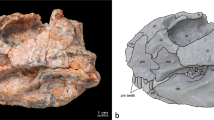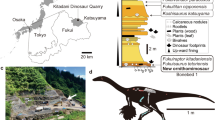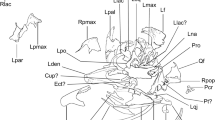Abstract
Ceratopsians (horned dinosaurs) represent a highly diverse and abundant radiation of non-avian dinosaurs1,2,3,4,5 known primarily from the Cretaceous period (65–145 million years ago). This radiation has been considered to be geographically limited to Asia and western North America1,2,3, with only controversial remains reported from other continents. Here we describe new ceratopsian cranial material from the Late Cretaceous of Iharkút, Hungary6, from a coronosaurian ceratopsian, Ajkaceratops kozmai. Ajkaceratops is most similar to ‘bagaceratopsids’ such as Bagaceratops and Magnirostris, previously known only from Late Cretaceous east Asia3,5,7,8. The new material unambiguously demonstrates that ceratopsians occupied Late Cretaceous Europe and, when considered with the recent discovery of possible leptoceratopsid teeth from Sweden9, indicates that the clade may have reached Europe on at least two independent occasions. European Late Cretaceous dinosaur faunas have been characterized as consisting of a mix of endemic ‘relictual’ taxa and ‘Gondwanan’ taxa, with typical Asian and North American groups largely absent10,11. Ajkaceratops demonstrates that this prevailing biogeographical hypothesis is overly simplified and requires reassessment. Iharkút was part of the western Tethyan archipelago, a tectonically complex series of island chains between Africa and Europe12, and the occurrence of a coronosaurian ceratopsian in this locality may represent an early Late Cretaceous ‘island-hopping’ dispersal across the Tethys Ocean.
This is a preview of subscription content, access via your institution
Access options
Subscribe to this journal
Receive 51 print issues and online access
$199.00 per year
only $3.90 per issue
Buy this article
- Purchase on Springer Link
- Instant access to full article PDF
Prices may be subject to local taxes which are calculated during checkout


Similar content being viewed by others
References
You, H. & Dodson, P. in The Dinosauria (eds Weishampel, D. B., Dodson, P. & Osmólska, H.) 478–493 (Univ. California Press, 2004)
Dodson, P., Forster, C. A. & Sampson, S. D. in The Dinosauria (eds Weishampel, D. B., Dodson, P. & Osmólska, H.) 494–513 (Univ. California Press, 2004)
Sereno, P. C. in The Age of Dinosaurs in Russia and Mongolia (eds Benton, M. J., Shishkin, M. A., Unwin, D. M. & Kurochkin, E. N.) 480–516 (Cambridge Univ. Press, 2000)
Xu, X., Makovicky, P. J., Wang, X.-L., Norell, M. A. & You, H.-L. A ceratopsian dinosaur from China and the early evolution of Ceratopsia. Nature 416, 314–317 (2002)
Makovicky, P. J. & Norell, M. A. Yamaceratops dorngobiensis, a new primitive ceratopsian (Dinosauria: Ornithischia) from the Cretaceous of Mongolia. Am. Mus. Nov. 3530, 1–42 (2006)
Ősi, A. The first dinosaur remains from the Upper Cretaceous of Hungary (Csehbánya Formation, Bakony Mts). Geobios 37, 749–753 (2004)
Maryańska, T. & Osmólska, H. Protoceratopsidae (Dinosauria) of Asia. Palaeontologia Polonica 33, 133–182 (1975)
You, H. & Dong, Z. A new protoceratopsid (Dinosauria: Neoceratopsia) from the Late Cretaceous of Inner Mongolia, China. Acta Geol. Sin. 77, 299–303 (2003)
Lindgren, J. et al. The first neoceratopsian dinosaur remains from Europe. Palaeontology 50, 929–937 (2007)
Holtz, T. R., Chapman, R. E. & Lamanna, M. C. in The Dinosauria (eds Weishampel, D. B., Dodson, P. & Osmólska, H.) 627–642 (Univ. California Press, 2004)
Pereda-Suberbiola, X. Biogeographical affinities of Late Cretaceous continental tetrapods of Europe: a review. Bull. Soc. Geol. Fr. 180, 57–71 (2009)
Csontos, L. & Vörös, A. Mesozoic plate tectonic reconstruction of the Carpathian region. Palaeogeogr. Palaeoclimatol. Palaeoecol. 210, 1–56 (2004)
Knauer, J. & Siegl-Farkas, Á. Palynostratigraphic Position of the Senonian Beds Overlying the Upper Cretaceous Bauxite Formations of the Bakony Mts in the Annual Report of the Hungarian Geological Institute of 1990, 463–471 (1992)
Ősi, A. Hungarosaurus tormai, a new ankylosaur (Dinosauria) from the Upper Cretaceous of Hungary. J. Vertebr. Paleontol. 25, 370–383 (2005)
You, H.-L. & Dodson, P. Redescription of neoceratopsian dinosaur Archaeoceratops and early evolution of Neoceratopsia. Acta Palaeontol. Pol. 48, 261–272 (2003)
Kirkland, J. I. & DeBlieux, D. D. in New Perspectives on Horned Dinosaurs (eds Ryan, M. Chinnery-Allgeier, B. & Eberth, D. A.) (Indiana Univ. Press, in the press).
Kirkland, J. I. & DeBlieux, D. D. In Ceratopsian Symposium: Short Papers, Abstracts and Programs (ed. Braman, D. R.) 90–95 (Royal Tyrrell Museum Palaeontol., 2007)
Wolfe, D. G. et al. In Ceratopsian Symposium: Short Papers, Abstracts and Programs (ed. Braman, D. R.) 159–167 (Royal Tyrrell Museum Palaeontol., 2007)
Bonaparte, J. F. Cretaceous tetrapods of Argentina. Münch. Geowiss. Abh. A 30, 73–130 (1996)
Rich, T. H. & Vickers-Rich, P. Protoceratopsian? ulnae from Australia Records of the Queen Victoria Museum Launceston; 113, 1–12 (2003)
Godefroit, P. & Lambert, O. A re-appraisal of Craspedodon lonzeensis Dollo, 1883 from the Upper Cretaceous of Belgium: the first record of a neoceratopsian dinosaur in Europe? Bull. Instit. Roy. Sci. Nat. Belg. Sci. Terre 77, 83–93 (2007)
Horner, J. R., Weishampel, D. B. & Forster, C. A. in The Dinosauria (eds Weishampel, D. B., Dodson, P. & Osmólska, H.) 438–463 (Univ. California Press, 2004)
Sampson, S. D. & Forster, C. A. Parallel evolution in hadrosaurid and ceratopsian dinosaurs. J. Vert. Pal. 21 (suppl.). 96A (2001)
Weishampel, D. B., Norman, D. B. & Grigorescu, D. Telmatosaurus transsylvanicus from the Late Cretaceous of Romania: the most basal hadrosaurid dinosaur. Palaeontology 36, 361–385 (1993)
Weishampel, D. B., Jianu, C.-M., Csiki, Z. & Norman, D. B. Osteology and phylogeny of Zalmoxes (N. G.), an unusual euornithopod dinosaur from the latest Cretaceous of Romania. J. Syst. Palaeontol. 1, 65–123 (2003)
Dalla Vecchia, F. M. Tethyshadros insularis, a new hadrosauroid dinosaur (Ornithischia) from the Upper Cretaceous of Italy. J. Vertebr. Paleontol. 29, 1100–1116 (2009)
Benton, M. J. et al. Dinosaurs and the island rule: the dwarfed dinosaurs from Haţeg Island. Palaeogeogr. Palaeoclimatol. Palaeoecol. (in the press)
Le Loeuff, J. The Campano-Maastrichtian vertebrate faunas from southern Europe and their relationships with other faunas in the world: palaeobiogeographical implications. Cretac. Res. 12, 93–114 (1991)
Prieto-Marquez, A. & Wagner, J. R. Pararhabdodon isonensis and Tsintaosaurus spinorhinus: a new clade of lambeosaurine hadrosaurids from Eurasia. Cretac. Res. 30, 1238–1246 (2009)
Pereda-Suberbiola, X. et al. The last hadrosaurid dinosaurs of Europe: a new lambeosaurine from the Uppermost Cretaceous of Aren (Huesca, Spain). C. R. Palevol. 8, 559–572 (2009)
Acknowledgements
We thank L. Kocsis, P. Barrett, D. Norman, P. Dodson, J. Kirkland, P. Makovicky, S. Sampson, P. Godefroit, Z. Csiki, J. Pálfy and R. Sissons for discussion, R. Blakey for the use of the palaeogeographical reconstruction, P. Gulyás for preparation, J. Kirkland for unpublished data and U. Göhlich for logistical support. Research was supported by the Hungarian Scientific Research Fund (OTKA PD 73021) and the Hantken Foundation (A.Ő.), and a Humboldt Postdoctoral Fellowship (R.J.B.). This is MTA–MTM Paleo contribution 109.
Author information
Authors and Affiliations
Contributions
A.Ő. collected the material. A.Ő. and R.J.B. carried out the anatomical description. A.Ő. prepared the figures. All authors discussed the results and contributed to the manuscript.
Corresponding author
Ethics declarations
Competing interests
The authors declare no competing financial interests.
Supplementary information
Supplementary Information
This file contains Supplementary Information comprising: Locality data; Previous reports of ceratopsian dinosaurs from Europe and Ontogenetic stage of the known material of Ajkaceratops; Supplementary Figures S1-S3 with legends and References. (PDF 403 kb)
PowerPoint slides
Rights and permissions
About this article
Cite this article
Ősi, A., Butler, R. & Weishampel, D. A Late Cretaceous ceratopsian dinosaur from Europe with Asian affinities. Nature 465, 466–468 (2010). https://doi.org/10.1038/nature09019
Received:
Accepted:
Issue Date:
DOI: https://doi.org/10.1038/nature09019
This article is cited by
-
Extreme tooth enlargement in a new Late Cretaceous rhabdodontid dinosaur from Southern France
Scientific Reports (2017)
-
Horned dinosaurs venture abroad
Nature (2010)
Comments
By submitting a comment you agree to abide by our Terms and Community Guidelines. If you find something abusive or that does not comply with our terms or guidelines please flag it as inappropriate.



